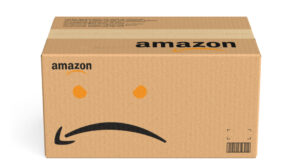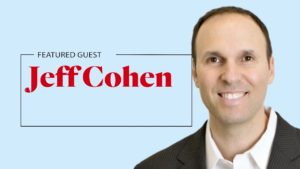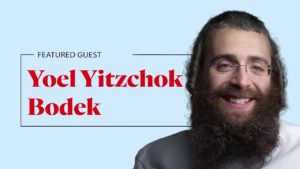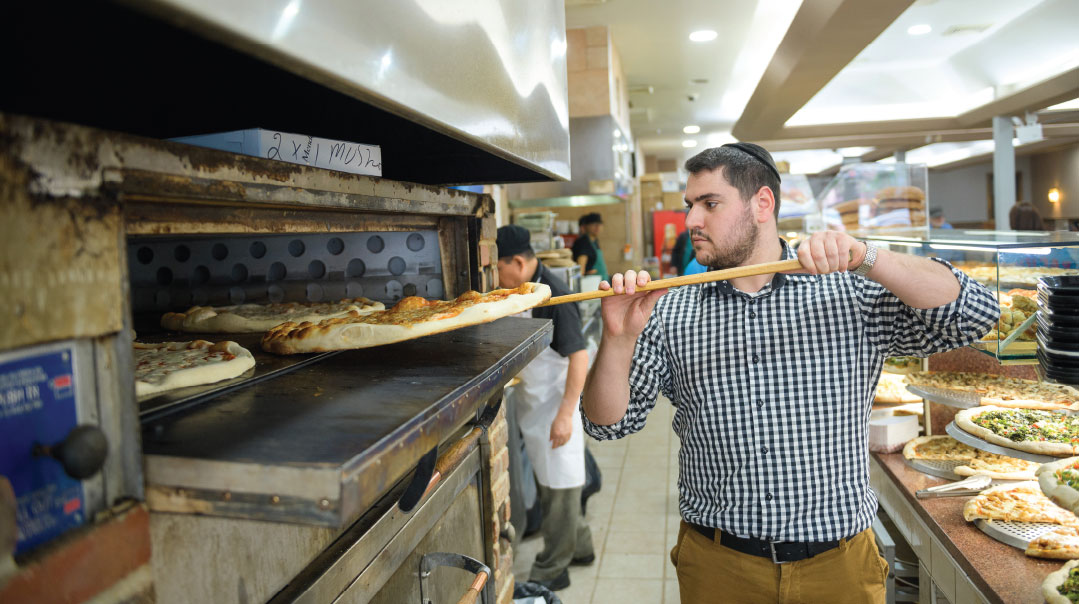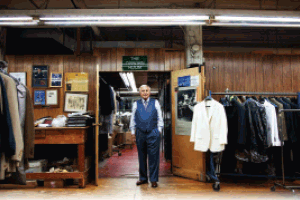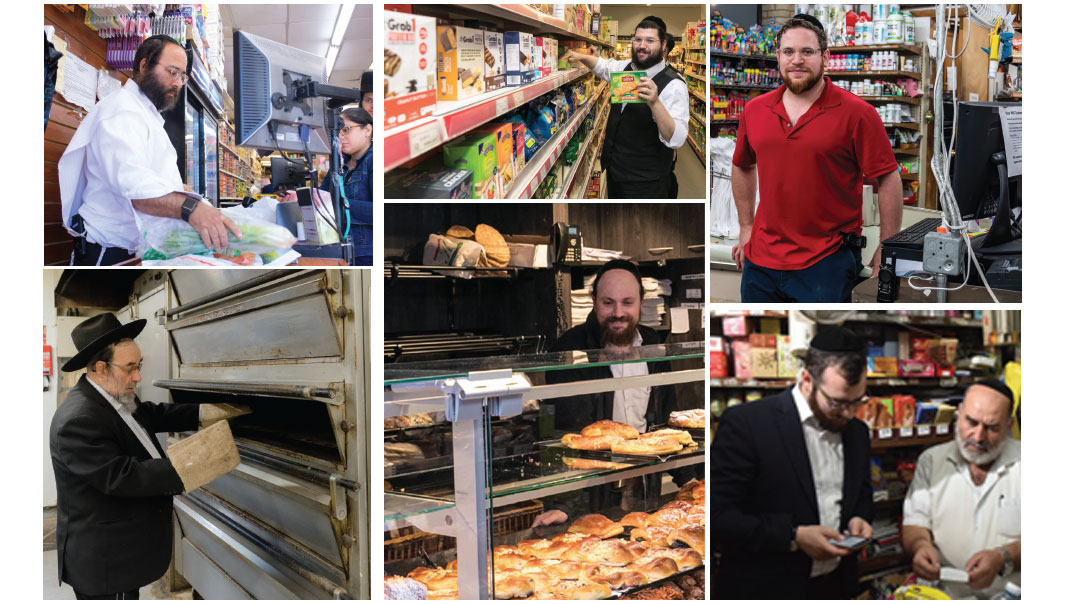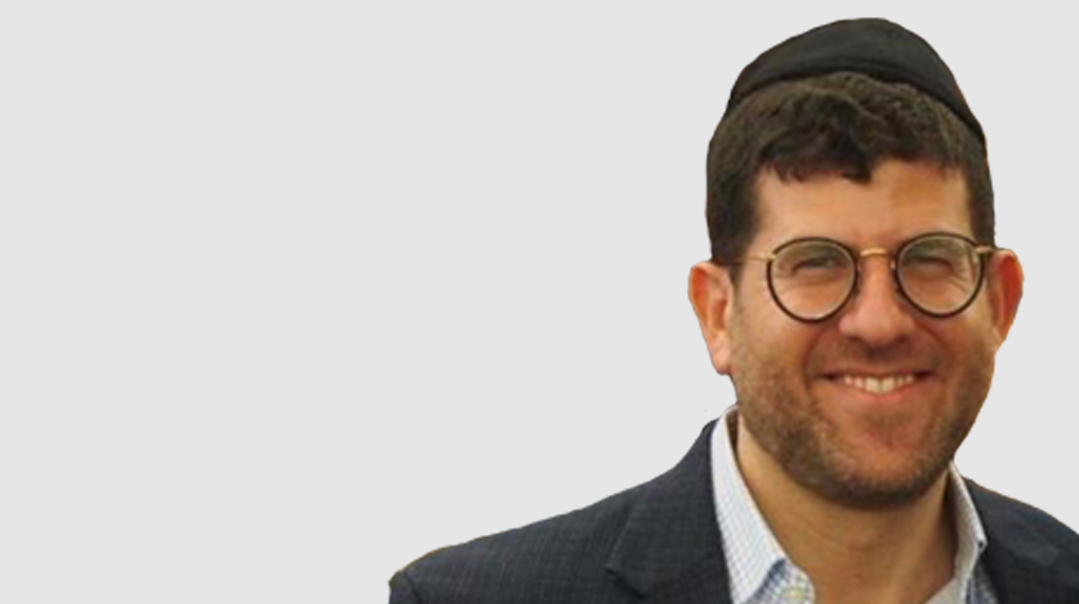The One True Esrog
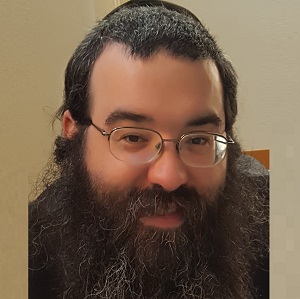
Rabbi Shalom Ghoori is an esrog expert on a mission to prove that the huge yellow fruit with the very edible sweet-tangy pulp is the pri hadar Chazal had in mind all along
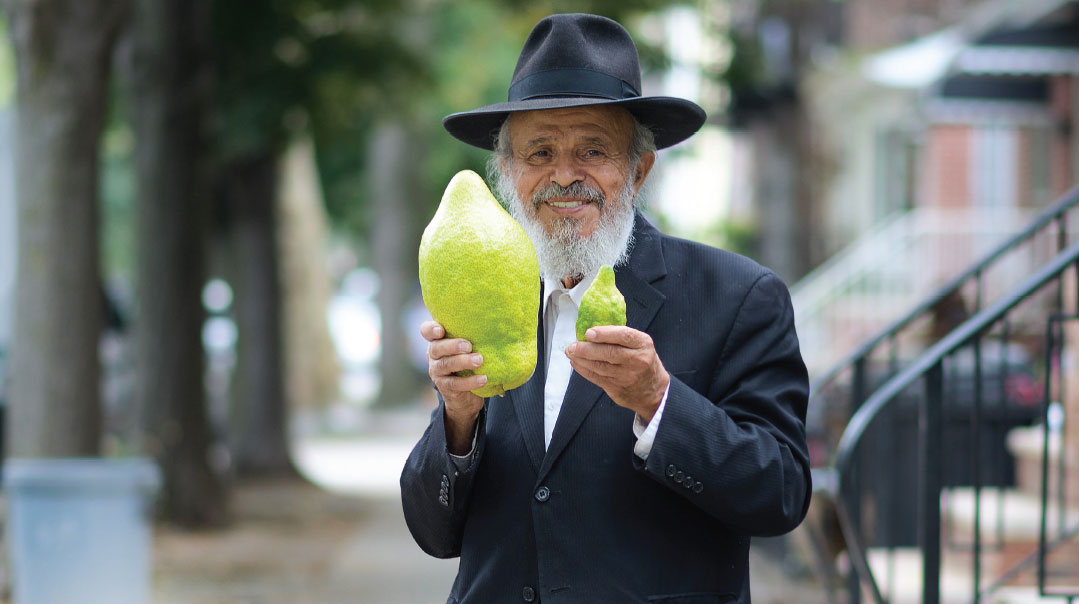
Photos: Naftoli Goldgrab
For many years, Rabbi Shalom Ghoori has been engaged in what can only be described as a labor of love and dedication. His mission is to make the unique esrogim he and his Yemenite ancestors have been using for millennia — most of which are externally identical to the average esrog, though some are papaya-sized and famously unwieldy — the esrogim of Klal Yisrael.
I recall seeing him set up shop several years ago in a shul in Flatbush a few minutes before Maariv. He gave a little talk about the attributes that an esrog must possess in order to make it suitable for the mitzvah, including the many places in Gemara suggesting that an esrog is a fruit meant to be eaten. He then cut open a standard esrog, the kind most people use, and showed off its innards: a small pulp, too sour to be edible, encased in a thick rind.
“These are not edible esrogim,” he said. “Let me show you the real esrog used by Chazal.”
The huge esrog he brought was then cut into pieces and handed out to the mispallelim for a quick taste test. While tangy, the esrog was indeed flavorful. What’s more, the rind was about the thickness of an average orange or grapefruit.
“You see?” he announced triumphantly. “The other esrog you cannot eat.”
Rabbi Ghoori, who authored a sefer on the subject called Esrog Chazal V’hamesores, can be quite persistent in his contention that the only proven kosher esrog today is the Yemeni esrog, which he refers to as the “esrog Chazal v’hamesores,” sometimes qualifying that it is the “Chazal esrog of the Yemeni variety.”
I discovered this during a recent visit with Rabbi Ghoori.
“The esrogim that are commonly used are not real esrogim,” he insists. “The Yiddishe esrogim, the kind brought down in the Gemara — those are the ones that we have. Those are the ones mentioned by the Chasam Sofer, the Rema, the Minchas Elazar.”
“So in your opinion,” I start, “the esrog that we use…”
“…is a murkav ,” he says with finality. “It’s grafted.”
“It can’t be a murkav if gedolei Yisrael used it,” I venture back.
“Who are these gedolei Yisrael?”
“The Chazon Ish. Most rebbes and rabbanim.”
“The Chazon Ish did not use it.”
This is merely the introduction. Rabbi Ghoori takes out his sefer, the one in which he takes readers through all his research advocating for Yemenite esrogim.
The Yemenite variety is not a new product. But Rabbi Ghoori believes his research establishes it as the purest esrog. And he wants communities around the world to know it.
“The Chofetz Chaim says in the name of the Gra that Hashem sometimes hides a chiddush from Klal Yisrael in order to give a certain person the credit for discovering it. This,” Rabbi Ghoori says, holding up his green-and-yellow-colored sefer, “is what Hashem gave me.”
Unadulterated Rabbi Ghoori’s battle to prove the authenticity of Yemenite esrogim can be linked to the disappearing tradition of Teiman.
“From 2,000 years of the Jewish community in Yemen, we are the last ones,” says Rabbi Ghoori, with a sad laugh.
Rabbi Ghoori has the charm of what you would imagine from the ancient Yemenite tradition. His guttural pronunciation of Hebrew terms, his frequent exclamations of “Yishtabach Shemo la’ad,” his enthusiasm, all bespeak a connection to the towering community said to have been established in the waning days of Bayis Rishon.
Teimani mesorah, it’s been said, is one of the purest among Klal Yisrael. It’s been handed down from father to son, from mori to talmid, for generations. After living for centuries in Yemen, a country located at the southwest corner of the Saudi peninsula, the great majority of the communities were airlifted to Israel in 1949 and 1950. Smaller communities also exist in the United States and England.
“See?” he tells me at one point. “I’m a Teiman’er so I can read backward.”
The community was so poor, and there were so few seforim, that children in Yemen were forced to learn how to read a sefer from each of its four sides, depending on where they were sitting.
A proud Yemenite, Rabbi Ghoori has been living for the past four decades in Boro Park, recently moving to Flatbush. He effortlessly shifts between the Ashkenazi and Yemenite dialects and has letters of approbations from gedolim of both communities supporting his research.
I look at the cover of Rabbi Ghoori’s sefer and see that his name is actually spelled Khoori, with a kuf. Yet it is pronounced as a gimmel. I ask him why.
“Is it my fault that you forgot how to pronounce the alef-beis?” he responds with a smile. “If kuf is pronounced as a ‘K,’ then how is it different than kaf? It’s actually pronounced as ‘guf.’ ”
Then what about gimmel, I ask?
“That,” he counters, “should be ‘jimmel’ ” — as in giraffe.
And daled, according to the Yemeni tradition, can be either hard or soft — just like beis and veis, or kaf and chaf. It can be pronounced either as “daled” or “thaled.”
“How do you pronounce t-h-e?” Rabbi Ghoori asks me. “That’s how you pronounce the soft daled. It cannot be that Lashon Hakodesh is missing sounds. Our language has every single sound.”
This gets me thinking. The Gemara in Berachos says that when enunciating the word “Echad” in Krias Shema, the focus should be on the daled, not the alef or ches. Poskim throughout the generations have struggled to understand how this might be possible.
The noble mesorah preserved for Klal Yisrael by Yehudei Teiman provides a simple explanation — it should be “Echathhhh.”
It’s Meant to Be Eaten
The proofs Rabbi Ghoori brings to buttress his argument are many and varied. The first page of his sefer, in fact, answers a question that’s been on my mind since we sat down together: Didn’t the Chazon Ish famously research all esrogim until he finally settled on one?
I am referring to the legendary tree growing in the front yard of the home of Rav Michel Yehuda Lefkowitz ztz”l, the late rosh yeshivah of Yeshivas Ponevezh L’tzeirim. The tree grew out of seeds given to him by the Chazon Ish, along with a brachah that it should grow and multiply.
To answer my question, Rabbi Ghoori points to a page in his book quoting Rav Moshe Illovitsky, a childhood friend of the Chazon Ish, who is cited in the sefer Pe’er Hador, that the gadol admitted in a letter that he had made a mistake when he said that he could discern accurately between grafted and non-grafted esrogim. The Chazon Ish, his friend contended, asked him to send him the same esrogim he had previously sent him while in Vilna, before he had certified his esrog as pure.
“All I am doing is showing you what it is says in Pe’er Hador,” Rabbi Ghoori insists.
[Ed. —The Rabbinical Board quoted verbatim these words of Pe’er Hador to the son of Rav Moshe Illovitsky (today in his mid-eighties). He responded that it’s impossible to rely on the language in the letter, as it’s unclear what they meant, and which esrogim they are referring to. Additionally, he added that he knows the Chazon Ish relied on Rav Michel Yehudah’s esrogim until the end of his life.]
Rabbi Ghoori opens up to another page, this time citing the Chasam Sofer on the features of a grafted Yanover esrog that is passul. The siman, he says, is that “the motz is wide and it has a lot of juice.” The Chasam Sofer quotes the Maharam Padua that “if you find this, it is certainly a murkav.”
“Motz and mohel,” Rabbi Ghoori says, “is pulp and juice. But the rabbanim in Europe didn’t know what motz is. The regular esrog is a murkav since it has a lot of pulp and juice.”
Other proofs in his book include a picture of a Yemenite market in which an Arab fruit vendor is selling esrogim year round as edible fruit. He cites the midrash that Potiphar’s wife gave her friends esrogim to cut when Yosef came in as proof that an esrog is meant to be eaten.
He then shows me a Tosafos in Succah stating that the pitom, which is traditionally believed to be on top of the esrog, is actually on the bottom and is merely another name for the oketz. It is also supposed to leave a hole when removed. This would be similar to the Yemenite esrog, which has no pitom on top and whose oketz is easily removable.
“I’m here in this country for 60 years,” he says. “Baruch Hashem I was able to put myself into writing this sefer. Yishtabach Shemo la’ad shel Borei olam.”
You Must Fix It
Shalom Ghoori was born in a small village near Sanaa, the capital of Yemen, and was orphaned about five years later. The passing of his father, Rav Yosef, was a harsh blow to the family and the small community. Rav Yosef had been the mori of the village’s only beis medrash, as well as the shochet and mohel.
Rabbi Ghoori and his three brothers were brought up by their mother, a strong woman whom he credits with raising a family of Torah Jews. As a child of eight he was spirited out of the country along with his family and taken to Eretz Yisrael, followed ten years later by his relocation to the United States.
Rabbi Ghoori started dabbling in esrog research about 20 years ago. He was on 13th Avenue purchasing an esrog when a fellow Teimani Yid saw him.
“How can it be that a Yid such as yourself can buy an esrog off the street without checking if it’s grafted?” the man remonstrated. “Are you not aware that the vast majority of esrogim today are murkav?”
Rabbi Ghoori responded that he was relying on the many rabbanim and admorim who bought these esrogim.
“He took a knife,” Rabbi Ghoori recounted, “and cut the esrog I had just bought. ‘This is a lemon,’ he tells me, then repeating, ‘This is a lemon. Here, take this esrog, this is a Chazal esrog.’ ”
The man pulled a Yemenite esrog from his pocket and handed it to Rabbi Ghoori, ending with a command: “Alecha l’takein, ki becha bachar Hashem — It is up to you to fix this because Hashem chose you.”
Rabbi Ghoori tried explaining to the man that he was too involved in his business to research esrogim. But the man persisted.
“Learn about it,” the Teimani talmid chacham told him.
Rabbi Ghoori ultimately took that command to heart, making the dissemination of the “Chazal esrog” his life’s mission. He threw himself into learning everything there is to know about esrogim and published his sefer last year .
“Hashem made me lose everything — I lost my house and I had to move — just so I could focus on this,” he says. “I feel that it’s all worth it.”
The Ghoori Family’s Precious Heirloom
The crowning glory of the Ghoori family is housed in a large beis medrash in Bnei Brak, the final stop in a long journey that began seven centuries ago.
The Ghooris own an ancient sefer Torah, said to be 700 years old, that was bundled out of Yemen along with the family. It was written by a mekubal who lived in Aden, the largest city in the southern part of the country. The Ghoori ancestor, according to family legend, traveled from his home region in the north to the mekubal to purchase it. It is called the Al-Adeni sefer Torah after its place of origin.
“This sefer Torah was written in kedushah and taharah,” Rabbi Ghoori says. “I remember when I was a kid, many people used to come for Krias HaTorah and then get a Mi Shebeirach afterward as a segulah for health.”
Rabbi Ghoori says that when he was sitting shivah in Boro Park after the passing of his brother seven years ago, a man who remembered the sefer Torah came by. He said that he traveled for three days in his youth to see the extraordinary Torah. The visitor attested that he heard from the locals in Yemen that there was once an attempted robbery in the shul where the sefer Torah was located. The thieves, Arabs from the area, were suddenly stuck to their places and couldn’t move. They remained cemented to the floor until the morning, when the mori came and freed them from their gluey imprisonment.
The sefer Torah is today located in Bnei Brak and is overseen by Rabbi Ghoori’s nephew.
Boosted Sales
Sales of the Yemenite esrog, or the “esrog Chazal,” have grown from year to year, Rabbi Ghoori says. This is probably due to the common sight across the Tristate area of the esrog in the hands of gedolei Yisrael as they make the brachah on Succos.
Today, he sells about 500 esrogim each year, with just two or three going to Yemenite Jews as his research gains renown. Rabbi Ghoori rattles off entire lists of gedolim who use his product as their primary esrog: For instance, Rav Dovid Feinstein uses his esrogim, as did Rav Yisroel Belsky, the late rosh yeshivah of Torah Vodaath. He shows me a letter from Rav Belsky stating that he used several esrogim during Succos but took the Yemenite one to make the brachah. Poskim from Rav Ovadiah Yosef to Rav Shammai Kehas Gross, the Belzer dayan in Jerusalem, have written that it is worthwhile to take the Yemenite esrog as a hiddur.
Rabbi Ghoori gets his esrogim from an orchard — not in Yemen as his forefathers did, but one near Be’er Sheva in Eretz Yisrael. Seeds from the traditional esrog were brought there decades ago and planted in the Holy Land. For the past 40 years Rabbi Ghoori has been bringing them over to the United States via ship.
The day I met Rabbi Ghoori was a week before his shipment was due to arrive. The esrogim are kept in quarantine for five days in Israel to ensure no tree-eating viruses are embedded in the fruit. Rabbi Ghoori says he’s never received the shipment late, but one year it did arrive only one week before Succos, instead of the regular three, giving him a fright.
Rabbi Ghoori has three categories for his produce — alef-alef, alef, and beis. They retail for the same price as the common esrogim, with the nicest ones going for $200, the second class for $150, and the third for $75.
No Grafts Here
By Rabbi Avrohom Reit
One of the most popular varieties of esrog is known as the Chazon Ish esrog. How did this esrog come to bear the name of a world renowned gadol?
In 1935, when Rav Avraham Yeshaya Karelitz (more commonly known by the name of his sefer, Chazon Ish) arrived in Eretz Yisrael, it was nearly impossible for the average Jew to buy a kosher esrog. In the period prior to and just after World War II, almost all esrogim available worldwide were halachically invalid because they were grafted, a pesul known as murkav.
Grafting occurs when a branch of a fruit-bearing tree is cut from its native tree and attached to a host tree of a different variety. Esrog trees are notoriously weak and susceptible to disease. Grafting produces a stronger, healthier, disease-resistant tree that can bear high-quality fruit. There is no sign on the fruit to indicate that it is grafted, and short of knowing a particular esrog’s full history, there is no way to know. Although some Acharonim offer clues to differentiate between the murkav and non-murkav of specific varieties, these signs were often proven to be unreliable. (See Chasam Sofer, Orach Chayim 207.) There isn’t even any scientific way to identify a murkav.
At the time of the Chazon Ish’s arrival, many major growers in Eretz Yisrael openly admitted to grafting their esrogim, and retailers would proudly advertise their wares as murkavim. Impressed by the beauty that grafting could produce, consumers would reward these growers and sellers with their patronage.
For centuries the Jews of Europe had obtained esrogim from the Mediterranean basin, but political changes in those countries and the turmoil of World War II had dried the old production centers, leaving few options for Jewish buyers.
My rebbi, Rav Dovid Feinstein shlita, told me that before World War II he would shop for esrogim with his father, Rav Moshe ztz”l. Out of hundreds of sellers on New York’s Lower East Side, barely any bothered to stock non-murkav esrogim. Only a handful of aging rabbanim were interested in them.
Rav Shlomo Brevda ztz”l described a similar situation in Eretz Yisrael. Not long after World War II, he went to Tel Aviv to shop for arba minim. The streets there were lined with stores and stalls all proudly selling grafted esrogim.
At one point the situation was so bleak that many feared that finding a kosher, non-murkav esrog would be impossible. Rav Shlomo Eliezer Alfandari, the famous Yerushalayim mekubal, felt compelled to write a treatise permitting the use of a murkav esrog when non-grafted varieties were unavailable.
The Chazon Ish was appalled by this situation, and set about to discover a strain of kosher esrogim. Long before he arrived in Eretz Yisrael, there were people who had searched for authentic esrogim there. Rav Shmuel Salant and Rav Yehoshua Leib Diskin both sent emissaries to search for non-murkav esrogim. Their agents traveled to the northern region of Eretz Yisrael to an area that had once been part of the Sultan’s royal arboretum. Some claimed that the Beis Yosef and Arizal had planted esrog trees there to provide kosher esrogim for the mitzvah. Whether or not that story was true, these trees had been considered to be non-murkav and the investigations bore out that case. Unfortunately, prior to the Chazon Ish’s involvement, no one had attempted to make these esrogim available to the wider population.
At one point the Chazon Ish had advocated using the Yemenite esrogim, since it was believed to be impossible to graft them with other fruits. However, it was demonstrated that it was possible to graft them with a fruit called a chavshusha, and once people began growing these esrogim commercially, the Chazon Ish abandoned that idea.
Eventually the Chazon Ish decided to go to Shechem to search for esrog trees that had once been authenticated by Reb Zorach Braverman with the support of Rav Yehoshua Leib Diskin. Nobody had kept track of these trees after Reb Zorach’s death in 1938.
The Chazon Ish studied the trees in Shechem carefully and selected some esrogim to use for the mitzvah. Afterward, he distributed the seeds to his talmidim to plant. The talmid most successful in growing esrogim was Reb Michel Yehuda Lefkowitz, a future rosh yeshivah in Ponevezh and the originator of the Lefkowitz variety of the Chazon Ish esrog.
Rav Michel Yehuda ztz”l once told me that he asked the Chazon Ish why he chose that particular esrog. The Chazon Ish replied, “I wandered among the trees in Shechem, analyzing their differences, and these seemed the most authentic.”
When asked how the Chazon Ish was sure it was not a murkav, Reb Michel Yehuda responded, “It is impossible for anyone who knew the Chazon Ish — who has any concept of his greatness — to entertain such a question. The Chazon Ish’s encyclopedic knowledge was mind-boggling. Being an amazing genius, he understood concepts that no one else could. Although the Chazon Ish never explained why he chose that particular tree, if after so much consideration he chose this tree, there is no question that it was a kosher esrog.”
A few years after choosing the first esrog, the Chazon Ish returned to Shechem together with Rabbi Nachum Yoel Halpern to choose another esrog. Passing through the Arab village of Umm al-Fahm, the Chazon Ish noticed a particular tree and told Reb Nachum Yoel, “This is a real esrog.” The Chazon Ish instructed Reb Nachum Yoel to take seeds from that tree and plant them in his yard on Rechov Maharshal.
The Chazon Ish strongly supported using either the Lefkowitz or Halpern varieties of esrog, and together they are the source for today’s Chazon Ish esrogim. Because the Chazon Ish invested time and effort in this new line of esrogim, they became known as Chazon Ish esrogim.
While almost all of today’s commercially available esrogim can be traced to a reliable source, the Chazon Ish esrog is the only one that has been researched, authenticated, and disseminated by an adom gadol. The sanction of Rav Yehoshau Leib Diskin and the approbation of the Chazon Ish has made these the esrogim of choice for bnei yeshivah.
Rabbi Avrohom Reit has spent several years researching and writing about the arba minim. He is the author of Lekicha Tama — A Lulav and Esrog Buying Guide (Feldheim Publishers),Teka Beshofar — Mastering Shofar Blowing, EZShofar — Everyone’s How-to Guide, Zeh Kaparosi — The Custom of Kaporos, Chalutz Hana’al — A Concise Overview of the Mitzvah of Chalitza.
(Originally featured in Mishpacha, Issue 781)
Oops! We could not locate your form.

